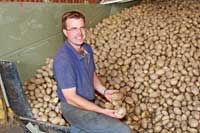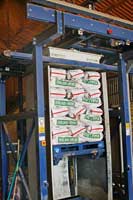Potato handling made simple

Each year, a large tonnage of potatoes leaves UK farms in paper bags stacked on pallets, which means there is a high number of bags to be filled and stacked. Andy Collings takes a look at how such potentially tedious operations are now automated
Bags of potatoes, convenient as they are in that they can be manually manoeuvred without too much effort, are not the most efficient way of transporting potatoes.
But it is the way the industry has developed over the years and, while an increasing volume of potatoes is transported in bulk, big bags or boxes, 25kg or 20kg bags remain the system of choice employed by many retail outlets.
Robotic arms
Creating and marketing automated systems for filling, stitching and stacking of bags on pallets has been the mainstay of several companies, most of which have opted to use robotic arms to stack the filled bags onto pallets.
 |
|---|
| A layer of bags is stacked on the metal floor which can be seen above the already stacked bags. When the layer is complete, the metal floor slides open to deposit the layer on the pallet. |
Herbert Engineering, based near Wisbech, Cambridgeshire, opted out of the robot arm stacking system some years ago and instead went for a palletiser which, although larger and more expensive than a robot system, is usually capable of greater outputs, creates better load stability and does not need such extensive guarding.
Herbert markets such machines built by Dutch company Verbruggen. Filled bags are automatically stacked in layers using a manipulator arm that grips individual bags and turns and places them in the correct position as they are delivered via a conveyor and an elevator from the bag filling unit.
Once a layer of five bags is completed, the metal floor is slid out from beneath them to deposit them on a pallet waiting just below.
Nearby Bliss and Clabon Farms, where 120ha (300 acres) of potatoes are grown each year, has one such unit working.
The farm, at Three Holes, near Wisbech, runs to about 360ha (900 acres) and also has sugar beet, onions and winter wheat among its cropping.
“We major on producing potatoes for the chip shop industry,” explains Patrick Clabon who runs the farm. “There are about 3000t stored in boxes and a further 1500t in bulk.” All the potatoes leave the farm in 25kg bags, some of them personalised with names such as “Pat’s Piper”, and go to merchants that supply chip shops all over the country.”
Cleaning and grading
A £200,000 grading, bagging and palletising system sees the potatoes taken out of store and delivered into a Herbert Contractor 1800 which cleans and grades the crop before it is delivered to an inspection table for manual removal of damaged tubers.
For cleaning, this machine is fitted with a star unit but hydraulic rollers, coil or multi-sep systems can be specified. Soil and stones land on a conveyor which takes them out of the building.
The bagger – a Morray machine – pre-weighs the potatoes in batches before they are delivered into paper bags. Bags are automatically placed in their filling position by arms and grips activated by compressed air.
When filled, the bags move along to the stitching department before beginning their journey to the PM-HE 600 palletiser. A short conveyor takes them to the base of an elevator from where they are then raised about 3m to the top of the unit. Another conveyor then takes the bags across a series of square rollers which agitate the contents of the bag to settle the potatoes, and then into the arms of the manipulator for the layers to be formed.
“Output is about 10t/hour with the rate limited by the capacity of the bag filling unit,” he says. “But the key point is that the potatoes are handled gently so their keeping quality is not impaired.”
When the pallet is fully loaded with nine layers for a total of 45 bags, a forklift is used to remove it and place it alongside others in preparation for the lorry to take them away to the merchant.
“We’ve had this system installed for two years now and I have to say that it has worked well,” he says. “Sometimes I wish it had a bit more capacity but then isn’t that always the case?”

